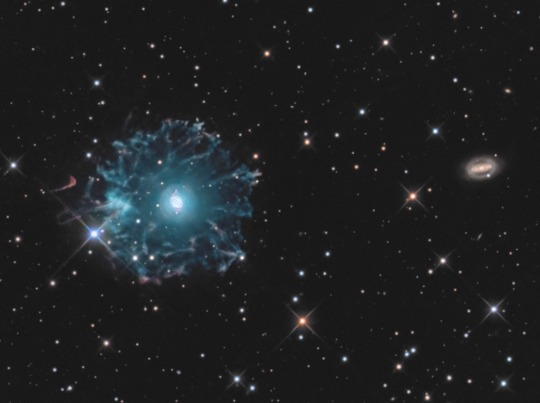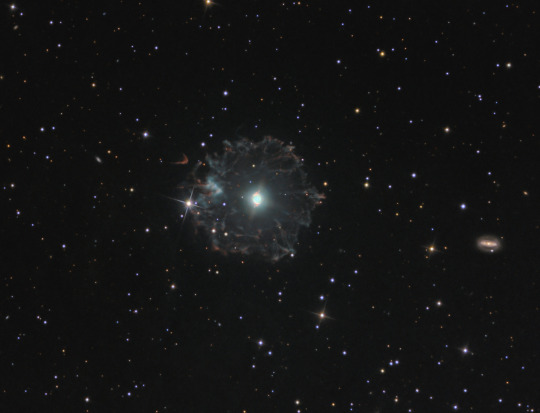#NGC 6552
Photo

The Cat’s Eye Nebula (NGC 6543, right) and NGC 6552 (left) // Filippo Scopelliti
#astronomy#astrophotography#nebula#emission nebula#planetary nebula#cat's eye nebula#NGC 6543#galaxy#spiral galaxy#barred spiral galaxy#star-forming galaxy#NGC 6552#draco
632 notes
·
View notes
Photo

2023 May 25
Cat's Eye Wide and Deep
Image Credit & Copyright: Jean-François Bax, Guillaume Gruntz
Explanation: The Cat's Eye Nebula (NGC 6543) is one of the best known planetary nebulae in the sky. Its more familiar outlines are seen in the brighter central region of the nebula in this impressive wide-angle view. But this wide and deep image combining data from two telescopes also reveals its extremely faint outer halo. At an estimated distance of 3,000 light-years, the faint outer halo is over 5 light-years across. Planetary nebulae have long been appreciated as a final phase in the life of a sun-like star. More recently, some planetary nebulae are found to have halos like this one, likely formed of material shrugged off during earlier episodes in the star's evolution. While the planetary nebula phase is thought to last for around 10,000 years, astronomers estimate the age of the outer filamentary portions of this halo to be 50,000 to 90,000 years. Visible on the right, some 50 million light-years beyond the watchful planetary nebula, lies spiral galaxy NGC 6552.
∞ Source: apod.nasa.gov/apod/ap230525.html
105 notes
·
View notes
Text
Explanation: The Cat's Eye Nebula (NGC 6543) is one of the best known planetary nebulae in the sky. Its more familiar outlines are seen in the brighter central region of the nebula in this impressive wide-angle view. But this wide and deep image combining data from two telescopes also reveals its extremely faint outer halo. At an estimated distance of 3,000 light-years, the faint outer halo is over 5 light-years across. Planetary nebulae have long been appreciated as a final phase in the life of a sun-like star. More recently, some planetary nebulae are found to have halos like this one, likely formed of material shrugged off during earlier episodes in the star's evolution. While the planetary nebula phase is thought to last for around 10,000 years, astronomers estimate the age of the outer filamentary portions of this halo to be 50,000 to 90,000 years. Visible on the right, some 50 million light-years beyond the watchful planetary nebula, lies spiral galaxy NGC 6552.

0 notes
Text

APOD: Cat's Eye Wide and Deep (5/25/23)
The Cat's Eye Nebula (NGC 6543) is one of the best known planetary nebulae in the sky. Its more familiar outlines are seen in the brighter central region of the nebula in this impressive wide-angle view. But this wide and deep image combining data from two telescopes also reveals its extremely faint outer halo. At an estimated distance of 3,000 light-years, the faint outer halo is over 5 light-years across. Planetary nebulae have long been appreciated as a final phase in the life of a sun-like star. More recently, some planetary nebulae are found to have halos like this one, likely formed of material shrugged off during earlier episodes in the star's evolution. While the planetary nebula phase is thought to last for around 10,000 years, astronomers estimate the age of the outer filamentary portions of this halo to be 50,000 to 90,000 years. Visible on the right, some 50 million light-years beyond the watchful planetary nebula, lies spiral galaxy NGC 6552.
© Jean-François Bax
0 notes
Photo

Cat s Eye Wide and Deep via NASA https://ift.tt/bs3i5hV
The Cat's Eye Nebula (NGC 6543) is one of the best known planetary nebulae in the sky. Its more familiar outlines are seen in the brighter central region of the nebula in this impressive wide-angle view. But this wide and deep image combining data from two telescopes also reveals its extremely faint outer halo. At an estimated distance of 3,000 light-years, the faint outer halo is over 5 light-years across. Planetary nebulae have long been appreciated as a final phase in the life of a sun-like star. More recently, some planetary nebulae are found to have halos like this one, likely formed of material shrugged off during earlier episodes in the star's evolution. While the planetary nebula phase is thought to last for around 10,000 years, astronomers estimate the age of the outer filamentary portions of this halo to be 50,000 to 90,000 years. Visible on the right, some 50 million light-years beyond the watchful planetary nebula, lies spiral galaxy NGC 6552.
1 note
·
View note
Text
Webb rileva idrocarburi policiclici aromatici nelle regioni nucleari delle galassie di Seyfert
Webb rileva idrocarburi policiclici aromatici nelle regioni nucleari delle galassie di Seyfert
Questa immagine, ripresa con il Mid-InfraRed Instrument (MIRI) di Webb, mostra la galassia a spirale barrata NGC 7469.
Gli astronomi hanno analizzato i dati disponibili al pubblico dello strumento Mid-Infrared (MIRI) del telescopio spaziale James Webb della NASA/ESA/CSA per tre galassie di Seyfert – NGC 6552, NGC 7469 e NGC 7319 – e hanno analizzato le proprietà dell’emissione di idrocarburi…

View On WordPress
0 notes
Photo

Cat's Eye Wide and Deep
Image Credit & Copyright: Josh Smith
Explanation: The Cat's Eye Nebula (NGC 6543) is one of the best known planetary nebulae in the sky. Its more familiar outlines are seen in the brighter central region of the nebula in this impressive wide-angle view. But the composite image combines many short and long exposures to also reveal an extremely faint outer halo. At an estimated distance of 3,000 light-years, the faint outer halo is over 5 light-years across. Planetary nebulae have long been appreciated as a final phase in the life of a sun-like star. More recently, some planetary nebulae are found to have halos like this one, likely formed of material shrugged off during earlier episodes in the star's evolution. While the planetary nebula phase is thought to last for around 10,000 years, astronomers estimate the age of the outer filamentary portions of this halo to be 50,000 to 90,000 years. Visible on the left, some 50 million light-years beyond the watchful planetary nebula, lies spiral galaxy NGC 6552.
Taken from NASA's Astronomy Picture of the Day
Space--Bot is a computer program that searches for space images.
#The Cat's
Eye Nebula (NGC 6543)#more
familiar outlines#in the life#have halos#planetary
nebula phase#mars approaches#space#space image#astronomy#nasa#science#space--bot
4 notes
·
View notes
Text
Кошачий глаз: широко и глубоко
http://astro-analytics.net
Туманность Кошачий глаз (NGC 6543) - одна из самых известных планетарных туманностей на небе. На этом широкоугольном снимке можно разглядеть более знакомые очертания центральной части туманности. Однако изображение составлено из множества снимков с большой и маленькой выдержкой, что позволило проявить очень слабое внешнее гало туманности. На расстоянии до туманности примерно в 3 000 световых лет гало протянулось более чем на 5 световых лет в поперечнике. Долгое время считалось, что планетарные туманности яв��яются финальной стадией жизни звезды типа Солнца. Недавно исследователи начали открывать у некоторых подобных туманностей наличие протяжённого внешнего гало, что говорит о сбросе внешних частей оболочки звезды во время более ранних эволюционных стадий. Возрасты планетарных туманностей оцениваются примерно в 10 000 лет, а время жизни внешнего гало может составлять от 50 000 до 90 000 лет. В левой части изображения видна спиральная галактика NGC 6552, расположенная в каких-то 50 миллионах световых лет от красочной туманности.
0 notes
Photo

(NASA) The Cat's Eye Nebula (NGC 6543) is one of the best known planetary nebulae in the sky. Its more familiar outlines are seen in the brighter central region of this impressive wide-angle view. But the composite image also combines many short and long exposures to reveal the nebula's extremely faint halo. At an estimated distance of 3,000 light-years, the faint outer halo is over 5 light-years across. Planetary nebulae have long been appreciated as a final phase in the life of a sun-like star. More recently, some planetary nebulae are found to have halos like this one, likely formed of material shrugged off during earlier episodes in the star's evolution. While the planetary nebula phase is thought to last for around 10,000 years, astronomers estimate the age of the outer filamentary portions of this halo to be 50,000 to 90,000 years. Visible on the right, some 50 million light-years beyond the Cat's Eye, lies spiral galaxy NGC 6552.
29 notes
·
View notes